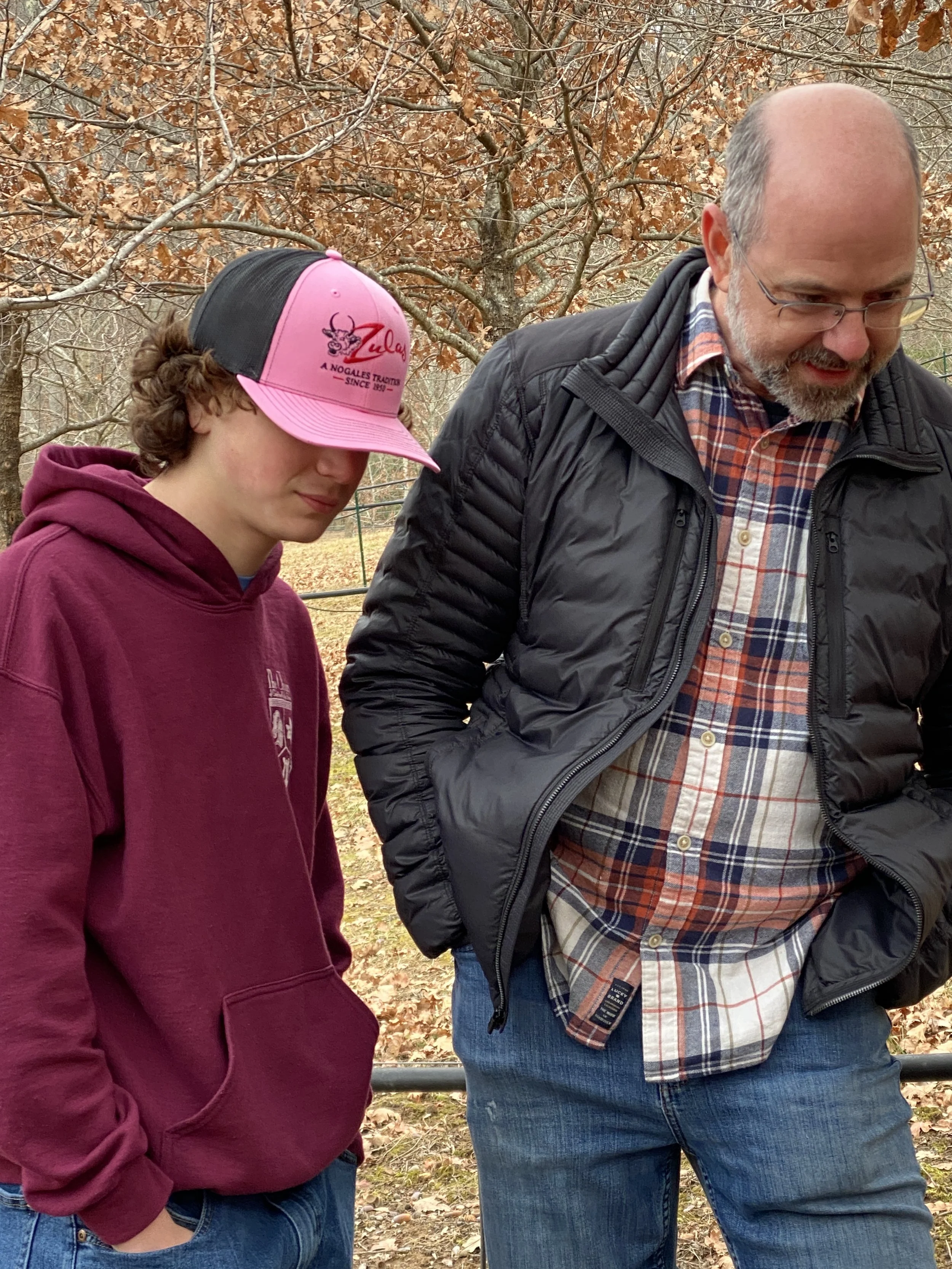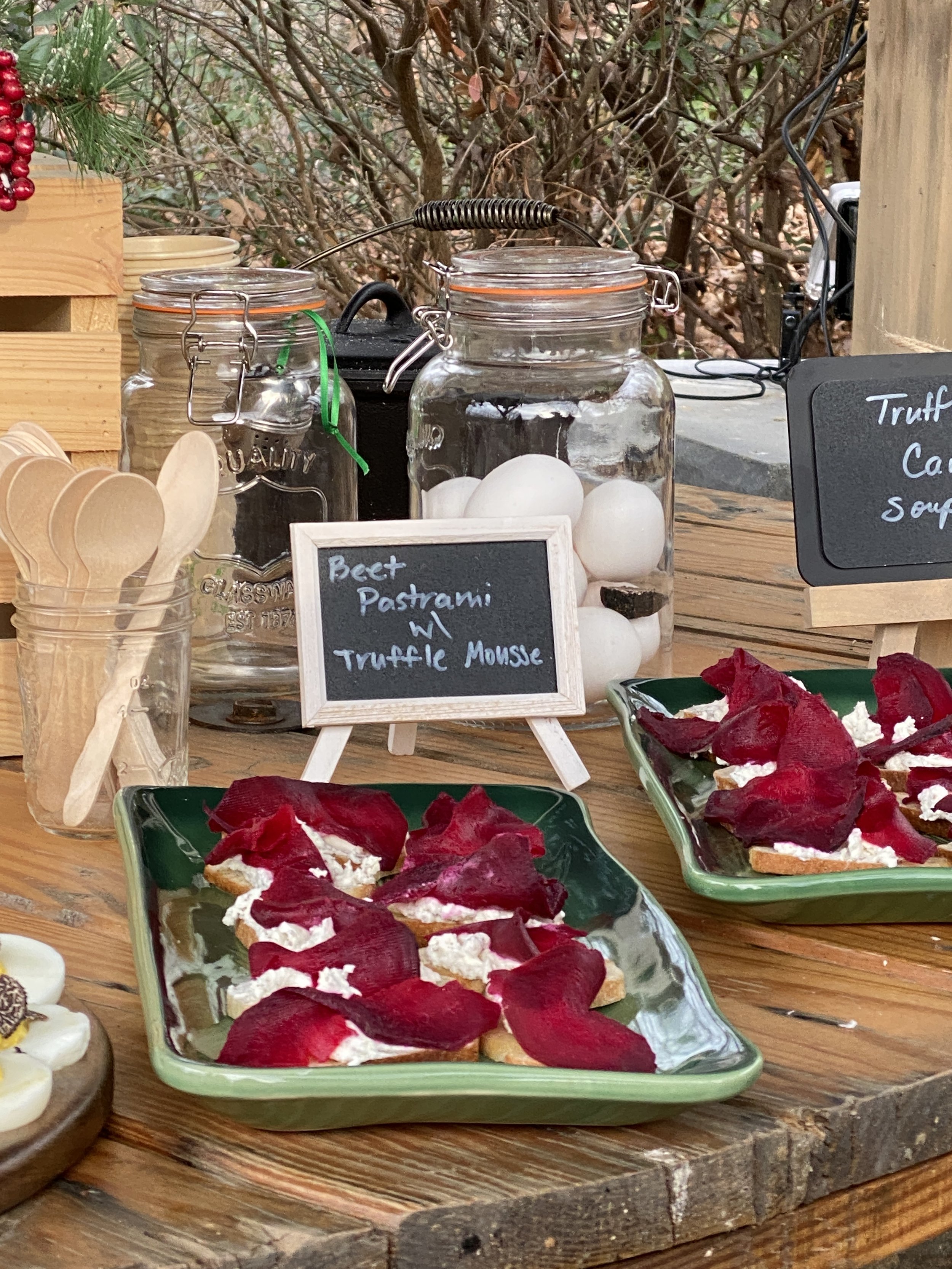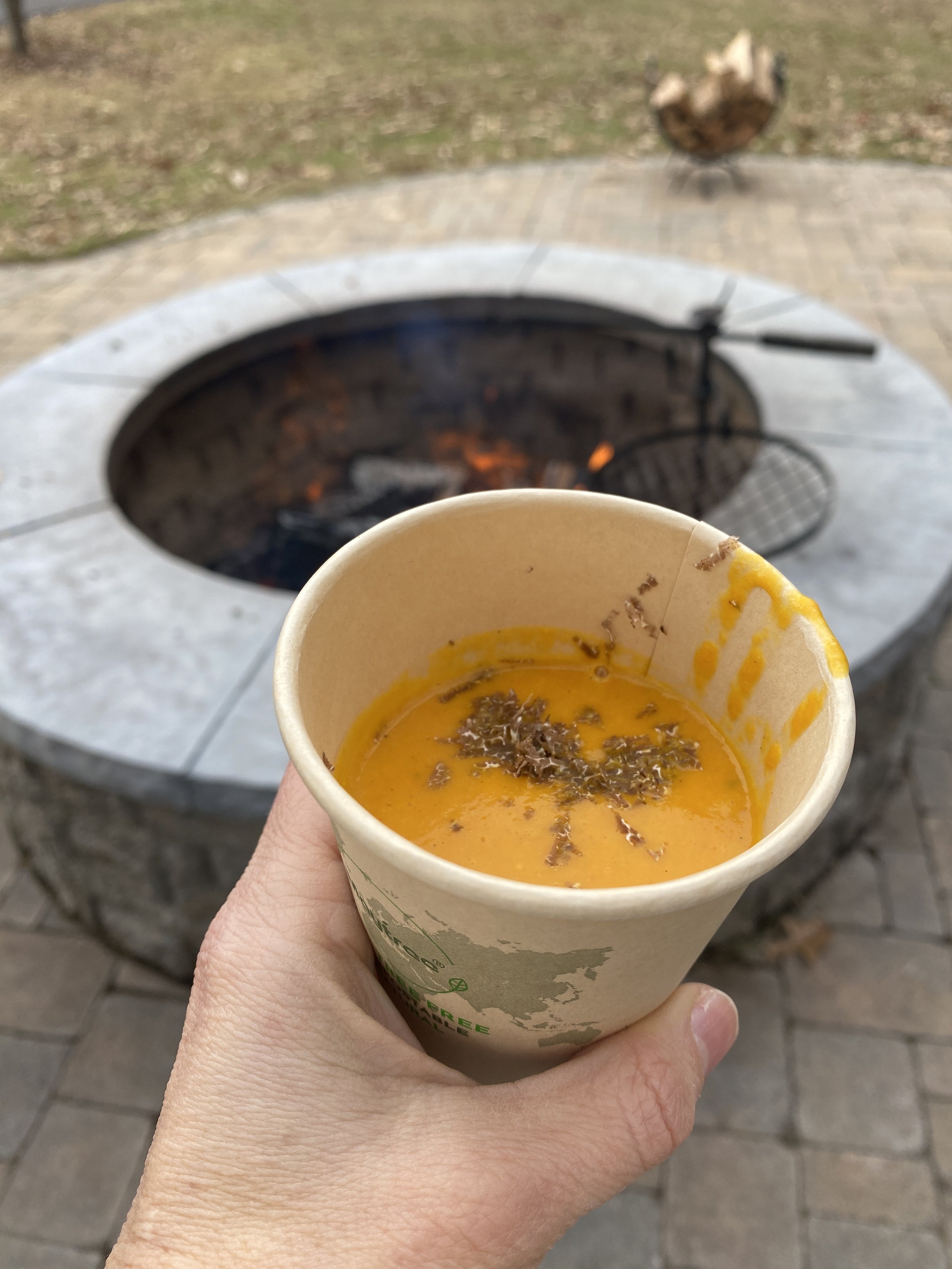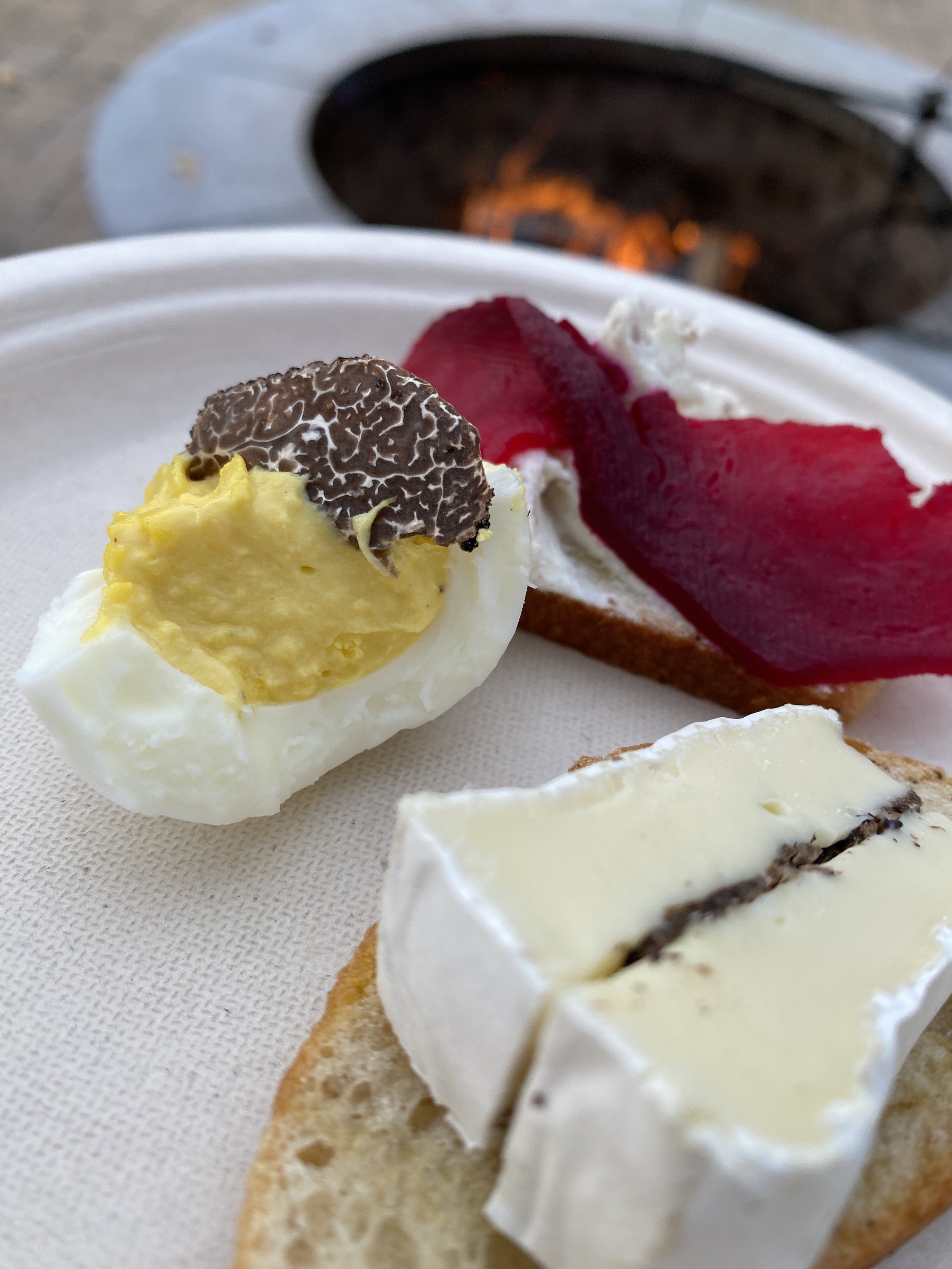Truffle hunting in Virginia? YES.
/I never understood the mania for truffles.
I know, I know, I need to relinquish my foodie card for such blasphemy, but I’m saying it. I never got the fuss. Most of the time, truffles tastes like cork shavings drenched in something akin to liquid smoke. You know, artificial and not quite fit for human consumption.
Believe me, I oohed and ahed and pretended I was into the world’s most expensive fungus (don’t quote this statistic, I’m totally making it up). But really, I kept sniffing, stretching my palate, wondering what I was missing.
Credit where credit is due, I never gave up trying to like truffles. Mostly because every once in awhile, I’d have truffle in some preparation that gave me pause, that forced me to reconsider. The first such taste was in Greve-in-Chianti, when I had bruschetta topped with lardo and a drizzle of truffle honey. The lardo (cured strips of fatback, often covered with pepper, rosemary, or other herbs) yielded slightly into the warm bruschetta, and the earthy sweetness of the truffle honey combined with the slightly porky bruschetta hit every single one of my texture and flavor needs.
Truffle honey? Check. That I like. At least that honey in that preparation.
Truffle oil, though? Disgusting. Though I discovered later that there’s good reason for that… in fact, truffle oil is reviled even by truffle fanatics, as it pairs oil on the verge of going rancid with pieces of truffle that are no longer good enough to use. I’m sure someone makes an excellent truffle oil with high quality oil and fresh truffle, but it doesn’t seem to be commercially available. In other words, best avoid.
truffle hunting in Virginia at Virginia Truffles
I did have a few lovely truffle moments in Umbria. Once at La Barbatelle Wine Bar where gifted chef Jennifer McIlvane explained that part of the problem is that black winter truffles (also known as Perigord truffles) need to be grated, not sliced, which made sense to me as sliced black truffles feel like, again, slices of cork. Grated on a microplane, they soften, take on a texture not unlike good quality parmesan.
I loved Jennifer’s light and sure application of black truffles, and I had one or two frittatas with grated truffle that I stared at, wondering how they were so excellent. But unfortunately, even when I limited my tasting of truffles to the grated variety, outside those few outliers, most of them I tried to like in vain.
Truffle hunting in Culpeper, Central Virginia at Virginia Truffles
It wasn’t until I read Truffle Hound that I started to understand why my response to what chef Brillat-Savarin called “the diamond in the kitchen” was so checkered and frequently underwhelming. Or even downright aggravating. While reading Truffle Hound (an excellent book, I recommend it wholeheartedly), I learned that truffles require a very specific set of circumstances to grow. Limestone in the soil (usually from nearby mountains), oak roots, earth favorable to mycelia. And a winter that’s cold but not too cold.
As long as those are in place, truffles grow. What this means for the consumer is that unlike wine or olive oil, terroir (the nature of a product’s territory) doesn’t impact the flavor of truffles. A Perigord truffle from Perigord France taste like a Perigord truffle from Umbria (where most of the world’s black truffles come from, though Spain seems to be fighting for this honor) taste like a Perigord truffle from Romania taste like a Perigord truffle from… you get the picture.
I know, this completely flies in the face of all the merchandising attempts of truffle producers or self-proclaimed foodies.
A black winter truffle is a black winter truffle is a black winter truffle.
At least at the moment it gets tugged from the ground.
It’s what happens after that matters. You see, truffles, whether farmed black ones or wild white ones (the white truffles from Italy’s northern region cannot be farmed), degrade quickly. And though dried porcini mushrooms bear enough of a passing resemblance to fresh porcini to make them useable, this is less true for truffles. An old black truffle tastes, to my palate, like…cork.
And this, I believe, THIS, is why I like truffles only rarely.
Once a truffle gets unearthed it must be weighed and graded and sold (usually in an auction type situation) and then shipped and then prepped.
Reading Truffle Hound, I began to realize that maybe those rare times I liked truffles, they were inside the freshness window. As I read on, I discovered that there are farms growing black winter truffles in the United States. If I could try one from one of those farms, the likelihood would be far higher that it would be fresh and that I would find it appealing. Maybe I’d finally get what all the fuss was about.
On a whim, I took to Google and discovered Virginia Truffles, a Perigord truffle farm A MERE HOUR AWAY. In Culpeper, Virginia. Culpeper! This won’t mean much to those outside of Virginia, but every local I’ve told this story to has let their mouth fall open. “In Culpeper????” Really, not much seems to have happened in Culpepper since the Civil War. How in the world could it be the scene of something as historic (in Europe) and also cutting-edge (in the US) as truffle hunting?
hunting black winter truffles at Virginia Truffles
Reading the website, I learned that after studying and learning at black winter truffle farms in Spain and Australia, the proprietors of Virginia Truffles inoculated their first oak seedlings in 2007. They unearthed their first truffles in 2018, and have since been selling their truffles (as well as ones from other areas), mostly to restaurants. Virginia Truffles’s success has allowed Virginia to join North Carolina and Tennessee as mid-Atlantic states that produce black winter truffles.
To my delight, I discovered that Virginia Truffle not only offers truffles for purchase, but also offers truffle hunting experiences. To my dismay, they were sold out for the season. I signed up for the farm’s newsletter and watched my inbox like a hawk. As soon as a the following year’s slate of dates were released, I signed us up.
Hunting for black Perigord truffles at Virginia Truffles
Honestly, I wasn’t totally sure what I’d signed us up for. But I figured worse case scenario, we’d overpaid for a nice December walk through oak trees. Still, I couldn’t help but hope our family of six would be set loose in the woods with a truffle dog, skipping merrily from tree to tree. The worst case scenario, I admitted on the drive, would be if the farm did what truffle hunting outfits in Italy often reputedly do, which is bury truffles for people to find. That kind of deceit would sour the day.
Well, on meeting the family behind Virginia Truffles, I let my fear evaporate. There was no way these earnest, passionate people would resort to subterfuge to trick novice truffle hunters.
The best possible scenario didn’t happen either—were we not sent out on our own with a dog and wished a merry truffle hunt. But as soon as we started the hunt, I understood why that scenario would be an impossibility. Truffle dogs are highly trained (and contrary to popular opinion, they do not need to be pricy Italian breeds…in Truffle Hound I learned that a Chihuahua won the Joriad North American truffle dog competition in 2018) so no truffle farm would allow their dog to get the kind of mixed signals that would come with novice hunters. Also, truffles are delicate. Taking them out of the ground without scratching them and without allowing the dog to inadvertently “autograph” them is tricky and best left to experts.
So after our introductory gathering at Virginia Truffles, where the owner, Pat, walked us through the history of truffle hunting in general and their farm specifically, we were sent out with Pat, Pat’s daughter Vanessa, and Nadine—their truffle dog, a mix with some hound.
As we moved through the trees, Pat pointed out the brûlée, a word to describe the lack of grass around an oak tree with developing truffles. The truffle mycelium sends out a chemical that prevents the growth of grass. If you pass a tree with brûlée, you could certainly dig around for truffles, but really, I can’t see how one could locate the precise location of a truffle without a dog like Nadine.
After Nadine crossed the stream to the first three acres of oak trees planted by Virginia Truffles (the most recent planting has yet to produce), she pressed her nose to the ground and within minutes was pawing at the earth. A bit of digging by Vanessa, a request that Nadine check her work, a bit more digging. That first time, Vanessa eventually gave up, theorizing that perhaps Nadine smelled a truffle that had recently been pulled from the earth. Likely a happy raccoon or similar animal, since all human excavations are diligently marked in the note taking. Modern truffle hunting seems eons away from the old days of crusty French or Italian men taking their dogs or pigs to the same secret spot in the dim woods, to snuffle at the ground while those overalled men offer up silent prayers that there will be truffles to elevate their evening frittatas. My friend from Spello told me his uncles offered to take him truffle hunting once but added they’d have to blindfold him for the drive. They seemed to only be halfway kidding.
Nowadays, this work is done in the light of day, at least at Virginia Truffles. When truffles are pulled from the ground, their position is noted because if a tree’s roots fails to produce truffles, those roots are inoculated again.
An interesting element of truffle hunting on a farm is learning the process of getting such a farm into production. Out of 1000 acorns started, they might only get a few hundred trees whose roots are able to support the fine network of mycelium that produce truffles. Even so, many of those oak trees won’t grow truffles, which means growers attempt to inoculate the roots again with a blend of truffles ground with water which can sometimes (but not always) take hold, allowing truffles to grow.
So that first rush of truffle possibility came up empty, but every single other time Nadine pawed at the earth, we found a truffle. Nadine was so unerring, I decided that that first time where nothing came up, it was likely just a little deeper.
The folks at Virginia Truffles bring visitors into the experience as much as they can given the needs of the truffles and the truffle dogs. Earth from around the truffle is passed around so we can get a whiff of what draws Nadine to the spot. The truffle aroma didn’t make the earth smell like mushrooms, which I expected, but rather like what my friend Graziano calls the nose of certain wines—sottobosco. Forest floor. The earth smelled like iconic, enriched, concentrated forest floor—disintegrating leaves, rich earth, the start of green, and the promise of growth.
There were two children on the hunt, and they were invited to help isolate the truffle by running their fingers gently around the perimeter, defining the edge of the truffle from the soil before rocking it gently to free it and then helping pull it up. One of the kids at first sniff of the truffle said he thought it smelled like tomato which made me laugh until I smelled it and holy moly it smelled just like tomato skin, sun warmed and ready.
Lest you think that finding truffles on a farm that grows them would eventually lose charm, kind of like finding eggs in a chicken coop, let me disabuse you. Every single time Nadine pawed at the earth, we all stalled, breathless.
And that breathlessness was rewarded, especially the time the excavated truffle was the biggest one any of us visitors had ever seen and may have shattered a farm record. Halfway between a baseball and a soccer ball, the thing was stunning. We all took photos of ourselves with it like it was an award-winning sailfish.
I enjoyed all of this—the interplay between nature and humanity and dogginess. But it didn’t convert me. An avowed truffle-sceptic, the hunt raised my respect and admiration for the process, but it didn’t increase my likelihood to drool over truffles on the menu.
That part came next.
While we were tromping around the oak trees, Vanessa’s husband Adam, who is a trained chef, prepared a spread to showcase the truffle. On offer:
deviled eggs, where the raw eggs were left in their shells to infuse with pieces of truffle in a jar. The truffle flavor moves toward fat, so the yolks of the eggs becomes a vehicle. Some of those eggs were hard boiled, and the yolks of others were used to make an aioli, which was combined with the hard boiled yolks for layers of truffle flavor. The egg was topped with a slice of truffle which offered less wow to the tastebuds than the egg, but was so, so beautiful.
a wheel of soft-ripened cheese, divided in half across the equator, truffles and seasonings spread across the lower layer before being reassembled and left to permeate into the cheese.
crisp crostini layered with truffled ricotta and goat cheese mousse, topped with pastrami made from smoked beets.
a carrot bisque topped with shaved, fresh truffle
This was the moment that the magic of the truffle surged from the ether, like sudden confetti across the brain. These bites were subtle, layered, nuanced. In none could you really have said THIS TASTES OF TRUFFLE. It was not the prominent flavor. Instead, I finally understood what Pat had explained earlier.
Truffles enhance flavor. They amp it. The eggs tasted like what eggs had always wanted to be but lacked the confidence to go for it. The beet pastrami tasted richer, smokier than a vegetable had any right to taste. The cheese tasted creamier, bloomier, the mushroom notes of a good brie heightened. The carrot bisque just tasted awesome, I don’t really know another way to explain it.
Gabe, who hates cooked carrots in any preparation begged me to learn to make it because it was his new favorite comfort food.
Adam and Vanessa talked about cooking with truffles and when they talked about getting steaks from the bison farm down the road (definitely checking that out) and grilling them, topped with truffle butter, it made me want to move in with this family (what are the odds that they’ll adopt me?). Interestingly though, I wonder if the place truffles may shine is with vegetarian foods—the fungus brings out all the levels of sweet and savory in foods and it’s nice to not have that compete with the more overwhelming flavors of meat. Though now that I’m thinking of it, a bit shaved into a beef tartare would be scrummy. And I’ll totally take that bison steak with truffle butter, please and thank you.
While we were oohing and ahhing and filching seconds and learning about how to infuse foods with truffles, Pat was in the lab. Once we polished off every single bite (and we did—they did not know what was coming when they allowed Damiani’s to join), we met her there.
Truffles are examined under a microscope to confirm their “breed”. Perigord truffles are more sought after (read: more expensive) than the kinds of truffles that grow wild around the Blue Ridge Mountains, like the Appalachian truffle. So the farm has to be careful to only sell Perigord truffles and only inoculate new tree roots (or re-inoculate roots from non producing trees) with Perigord truffles. The worst possible thing to happen to a Perigord truffle farm is to have some renegade truffle invade and populate the mycelium.
In fact, the lab at Virginia Truffles is so high-end, they classify truffles that other hunters have unearthed in the region.
It was quite a thrill so see the day’s truffles cleaned and weighed, and to learn what factors went into pricing a truffle, such as size and the number of lobes, and the amount of damage from bugs or a reckless bout of autographing by the truffle hound.
I also loved the tales of truffle errors—like when Vanessa told us how it kills her to see truffles stored in rice at grocery stores. It’s a nice way to infuse your rice, but a horrible way to store your truffle, as it dries it out and reduces its already short shelf-life. Also, Pat told us about how she saw a truffle at a grocery store that was listed as a local Perigord truffle. In the middle of summer. The truffle was either not local, because they only grow in winter so it would have to have come from someplace currently in winter, or it was way too old to sell, or it was not a Perigord truffle. She took it up with management, hating to have an unsuspecting buyer get taken in, but had little luck.
Truffle education complete, we were each given a certificate “signed” with Nadine’s paw print (this dog must be the most patient of hounds) and offered a discount on the day’s truffles. Surprisingly, none of us visitors went for the $900 sailfish truffle, even with the steep discount offered for us truffle finders. But we did buy ourselves a small one. Honestly, how could we not? We’d never have a fresher truffle and with the discount they offered, it seemed a steal. My mind churned with all the ideas Adam and Vanessa had offered for how to incorporate truffles into everyday cooking.
We also bought a jar of truffle honey produced by a nearby farm that raises summer truffles, rather than Perigord truffles. Of course, my mind was stuck on that bruschetta with lardo and truffle honey from Greve-in-Chianti. It may be time to replicate that, if I can get my hands on lardo.
For the moment though, I have the memory of truffled scrambled eggs that we enjoyed for many days after the truffle hunt—the whole, raw eggs infused with truffle that we then grated over the eggs once softly scrambled. The simple application elevated simple scrambled eggs into a rare and beautiful food. What’s more, there’s this afterglow, for hours, where the senses are subsumed with truffley beauty.
With the rest of the truffle, I softened grass-fed European butter and folded it with grated truffle. I will admit to you with almost no shame that after I put the containers of truffle butter in my freezer I—wait for it—licked the bowl clean. Of butter. Again, it’s not that it tasted truffle-y, it’s that it tasted like a fever dream of what butter aspires to be. I served that butter on tajarin (Piedmont’s egg-yolk tagliolini pasta) for New Year’s Day and we were a table of reverent and hushed worshippers at the altar of truffles.
Quite a change from the days of at shrugging off truffle appreciation as so much wasted energy.
What I didn’t bring home was a t-shirt. I regret few things in this zany and unpredictable thing called life, but I do regret not getting a permanent reminder of this day!
After all, how often do we get the opportunity to celebrate the synergy of community, food, nature…and hound?
Want more food discoveries in your email inbox once a month? Sign up for my newsletter, The Grapevine, and you’ll also get travel secrets, food for wanderlust, and, as a special welcome to the Grapevine community, an electronic copy of my bestselling novel set in Italy, Santa Lucia! Imagine that, in just a few minutes, you can escape to the beauties, mysteries, and flavors of Italy.



































